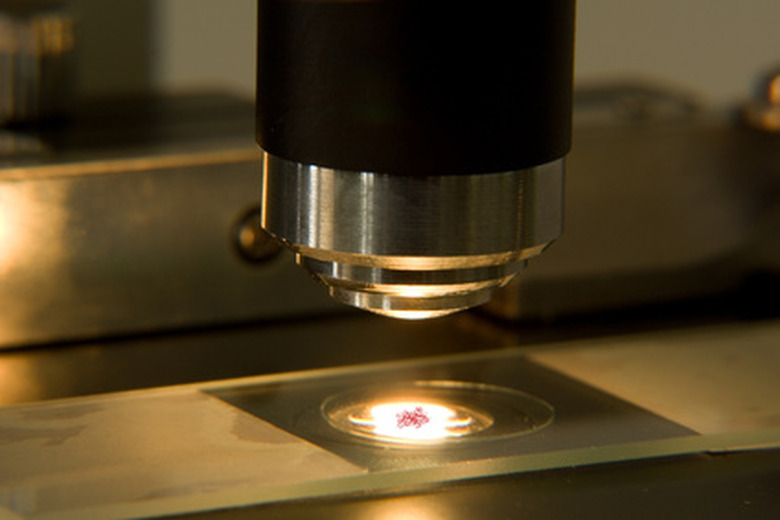How To Observe Human Cheek Cells Under A Light Microscope
Observing human cheek cells under a microscope is a simple way to quickly view and learn about human cell structure. Many educational facilities use the procedure as an experiment for students to explore the principles of microscopy and the identification of cells, and viewing cheek cells is one of the most common school experiments used to teach students how to operate light microscopes. The observation uses a wet mount process that is straightforward to achieve by following an effective preparation method. You can replicate the observational experiment at home or in the classroom with any standard light microscope with magnification settings of X-40 and X-100.
Swabbing for Cheek Cells
Swabbing for Cheek Cells
To obtain the cheek cells you'll use for observation under the microscope, you'll need a toothpick. Using the non-sharp end of the toothpick, you can swab the inside of your cheek and collect a sample of cells. To do this, place the toothpick at the bottom of your cheek and move the toothpick up horizontally to collect cheek cells. Be careful not to scrape the inside of your cheek too hard, because the epithelial lining is delicate and you can cause it to bleed.
Preparing the Microscope Slide
Preparing the Microscope Slide
Once you've collected your sample of cheek cells, place the swabbed end of the toothpick onto the middle of a microscope slide. Add a single droplet of water squeezed from a plastic pipette onto the center of the slide. Rotate the toothpick in the water to release the human cheek cells into the drop of water. Next, add one drop of methylene blue to the water and cell solution to stain the cheek cells. This will allow you to more easily see them during observation. If methylene blue cannot be used or obtained, a drop of iodine can be used as a substitute. Once the cells have been stained, position a cover slip at a 45 degree angle just inside the left edge of the solution. Move your fingers down and to the right to place the cover slip over the cheek cell mixture. Be careful when handling cover slips, because they break easily.
Tidying and Mounting
Tidying and Mounting
Once the cover slip has been placed over the cheek cell mixture, check for any tiny air bubbles under the cover slip. Air bubbles can interfere with the observation process: if you see any under the slip, lightly push the cover slip downwards to release any air bubbles you find. Once you've cleared out any air bubbles, place the edge of a paper towel on any solution outside of the cover slip to absorb the excess moisture. You can then mount the human cheek cell slide on the light microscope viewing platform. On some models of microscope, this is as simple as placing the slide on the viewing platform — follow your microscope's instructions to properly mount the slide.
Observing Cheek Cells
Observing Cheek Cells
Once your slide is mounted and the microscope is turned on, choose the X-40 magnification setting on the light microscope. Look through the viewing lens, and turn the focusing dial to adjust the focus until you see a clear and crisp image. Observe the human cheek cells by looking for irregularly-edged circular structures with a dark center, or nucleus. To see more of the cheek cells in detail, you'll need to increase your microscope's magnification. Try changing the light microscope's magnification to X-100, then turn the focusing dial to refocus the lens for image clarity if necessary. Now that you've increased the magnification, observe the increased cell detail that the extra magnification provides. Take note of the different structures inside the human epithelial cheek cell, like the cell membrane around the cell sample and nucleic structures inside the cell's cytoplasm.
Things Needed
- Toothpick
- Microscope slide
- Plastic pipette
- Methylene blue or iodine
- Cover slip
- Paper towel
Cite This Article
MLA
Humphries, Jane. "How To Observe Human Cheek Cells Under A Light Microscope" sciencing.com, https://www.sciencing.com/observe-cells-under-light-microscope-7888146/. 19 October 2018.
APA
Humphries, Jane. (2018, October 19). How To Observe Human Cheek Cells Under A Light Microscope. sciencing.com. Retrieved from https://www.sciencing.com/observe-cells-under-light-microscope-7888146/
Chicago
Humphries, Jane. How To Observe Human Cheek Cells Under A Light Microscope last modified March 24, 2022. https://www.sciencing.com/observe-cells-under-light-microscope-7888146/
